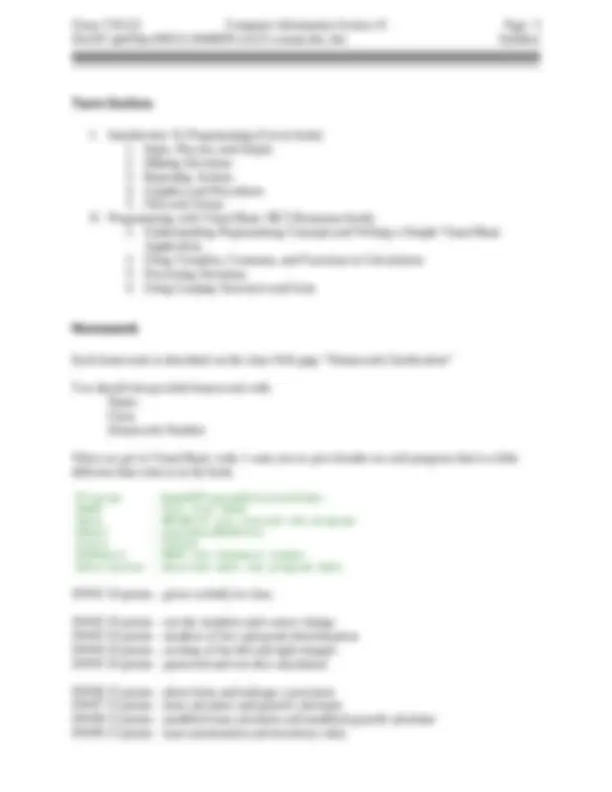



Study with the several resources on Docsity

Earn points by helping other students or get them with a premium plan


Prepare for your exams
Study with the several resources on Docsity

Earn points to download
Earn points by helping other students or get them with a premium plan
Community
Ask the community for help and clear up your study doubts
Discover the best universities in your country according to Docsity users
Free resources
Download our free guides on studying techniques, anxiety management strategies, and thesis advice from Docsity tutors
The syllabus for computer information science ii (cis121), a college course focusing on structured programming and object-oriented programming concepts. Students will learn top-down programming techniques, flowcharting, and event-driven programming. The course includes quizzes, homework assignments, midterm and final exams, and class participation. Required textbooks are 'logic and design' by thad crews and chip murphy, and 'visual basic.net programming for business' by philip koneman.
Typology: Exams
1 / 3

This page cannot be seen from the preview
Don't miss anything!


DocID: qkd33p-436212-2648829-cis121-s-main-doc.doc Syllabus Class Number: CIS121 Section: ______ Class Title: Computer Information Science II ( structured programming ) Time: _________ Days: _______ Prerequisites: CIS120 or concurrent enrollment Class Page: http://newterra.chemeketa.edu/faculty/rjohnson/courses/cis121/ Academic Information page: http://www.chemeketa.edu/attending/studentrights/ Instructor: Robert Johnson Office: Building 37 Room 126 Phone: 503-399-6074 E-mail: rjohnson@chemeketa.edu Office Hours: _____________________ (as given first day of class) Course Description This is the second of the three core CIS courses. It consists of introduction to the fundamental logic in designing specific algorithms for processing information typified by management information systems. This is an introduction to structured programming and object oriented programming concepts. Emphasizes structured problem solving and event driven programming techniques to develop software. Students will design, code, test, and debug several programs. Learner Outcomes: After successful completion of this course, the student should be able to: Apply Top-Down structured programming techniques Draw a flowchart of a process and write one or two sentences describing the process Identify and use each of the 3 program structures Use Visual Basic language to write the code for a program solution from a standard design chart or diagram algorithm Manage time to meet project deadlines Required Materials Text: Logic and Design Author: Thad Crew and Chip Murphy Text: Visual Basic.NET Programming For Business Author: Philip Koneman (Textbook bundle comes with VB.NET) Storage: You will need either diskette or other storage to carry your files on Grading The course grade will be determined by the following: a. Tests - There will be two tests, a midterm and a final. Each test will be worth 100 points. All tests are closed book. Tests consist of multiple choice questions, short answer fill-in, flowcharting, and program coding. NOTE: NO MAKE-UP EXAMS WILL BE GIVEN. If you are going to miss a test, it is your responsibility to contact the instructor, BEFORE THE TEST IS GIVEN. There are questions based on material not covered in the book but only in lecture.
DocID: qkd33p-436212-2648829-cis121-s-main-doc.doc Syllabus b. Quizzes - There will also be unannounced quizzes that will figure into your grade. NOTE: It is NOT possible to make-up or arrange alternate times for quizzes. c. Homework Assignments - As assigned, described below. You need to staple all papers together (in correct order) into a single homework submission. Once a homework assignment is graded the score is set. You don't resubmit homework to get back points you missed. Penalty for late work ranges from loss of points to not being graded at all. Late penalties occur regardless of the reason. d. Class participation - I reserve the right to institute additional class participation points. This could be worth up to 10% of your total grade. Institution of this will depend on class preparedness and discussion. If you do not want this, then come to class prepared to discuss the material for that day and participate in discussion. e. Grading Scale - I use a straight 100, 90, 80, scale, I may modify it slightly based on class performance. The grade scale is as follows: 100-90% = A 89-80% = B 79-70% = C 69-60% = D 59-35% = F 34-00% = N (no grade) f. An incomplete will only be given if you are missing 2 (two) pieces of required work. An incomplete is to handle some emergency at the end of the term NOT to give you more time to do work that is already past due. Please be aware of the implications of falling behind in this class. I don't like to tell people that an incomplete is NOT an option but I must maintain academic standards that hold you responsible for completing a class during the term like the other students did.
Do questions at the end of each chapter, but DO NOT hand in, use as test review Completely understand each of the key terms Attempt Programming Exercises in addition to those assigned Look at the examples in T:\ JOHNSON\OUTBOX\CIS T:\ Johnson\Outbox\CIS121\ClassExamples (pre-made examples) T:\ Johnson\Outbox\CIS121\InClass (items done in class) T:\ Johnson\Outbox\CIS121\KonemanStudentFiles2003(needed for book exercises) DO NOT GET BEHIND IN THIS CLASS! YOU MUST KEEP UP WITH THE CLASS! DO NOT BE AFRAID TO COME TO MY OFFICE FOR HELP. HAVE A PRINTOUT IN ORDER TO SOLVE PROBLEMS!!!! LOOK AT THE CODE!